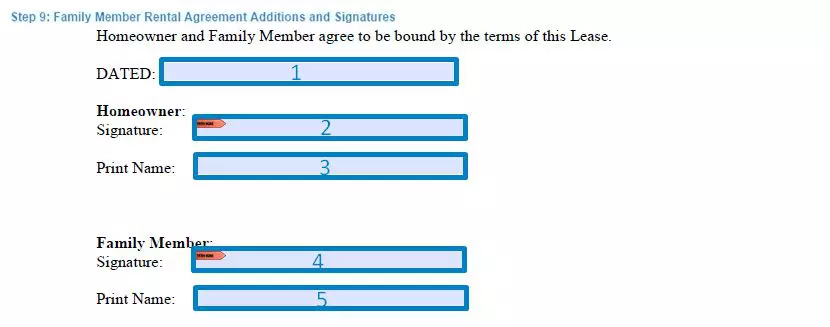Family Member Rental Agreement Templates
Even when you’re living with family, you might want to have a lease agreement. Rental agreements between family members can be even more important as family members get older, or if they start assuming that they have a right to live with family. Living with family can be fantastic. But just because you’re living with family doesn’t mean that you don’t still need to have a legal agreement. Family rental agreements can help preserve your relationship and make it easier to get out of a bad living situation with your family.
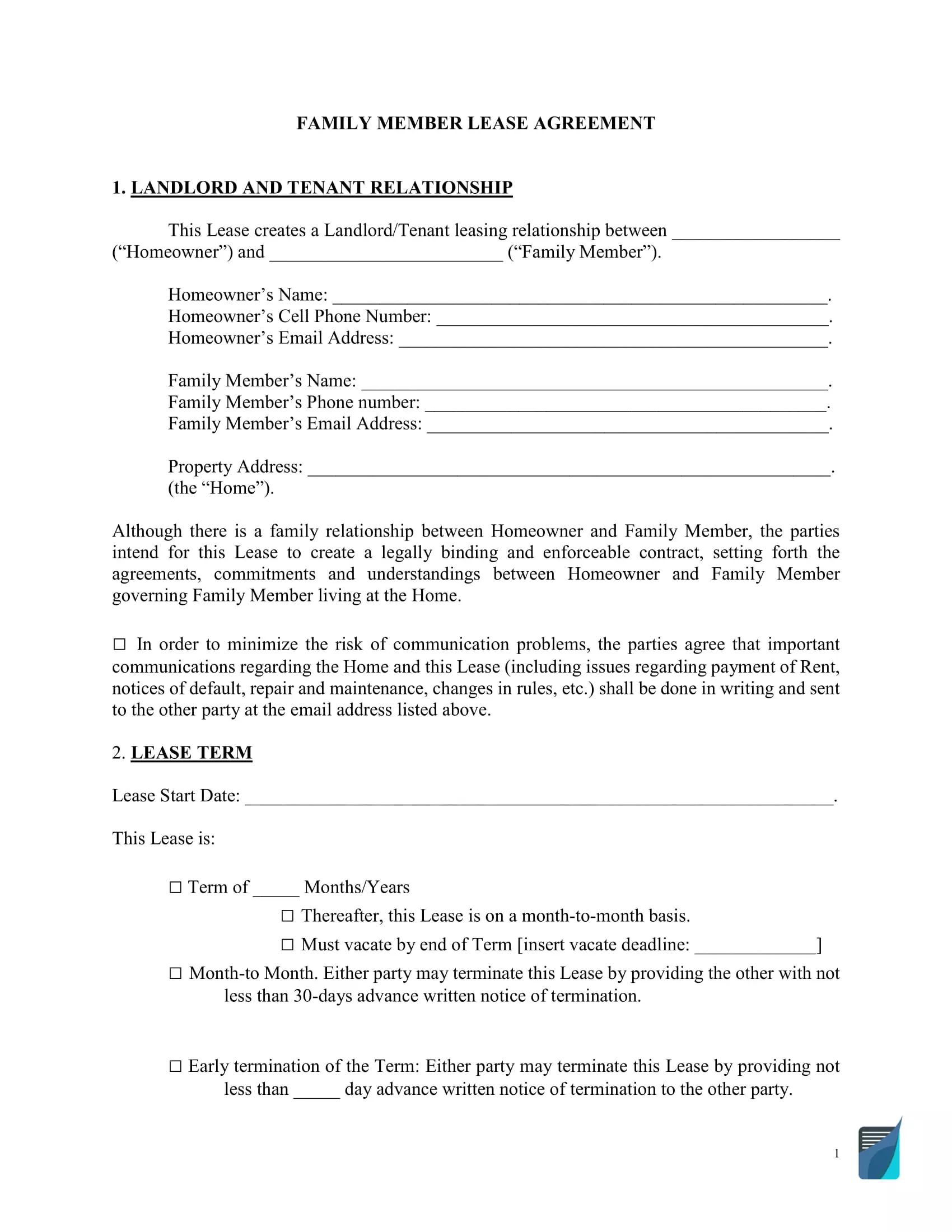
Build Your Document
Answer a few simple questions to make your document in minutes
Save and Print
Save progress and finish on any device, download and print anytime
Sign and Use
Your valid, lawyer-approved document is ready
Pros and Cons of Having a Family Rental Agreement
While it’s a good idea to have a family rental agreement, there are some pros and cons that come along with having one. Here are some important things to consider before you decide to suggest a family rental agreement.
Pros:
- Legal assurance of rent
- Lays out expectations for the property
- Allows you to create rules
- Allows you to limit the rental time frame
- Provides a framework for ending the lease
Cons:
- Can upset family members
- May be difficult to enforce
- Family may not take the agreement seriously if you don’t enforce the rules
What to Include in the Agreement?
There are a lot of things you can include in a family rental agreement. Our family rental agreement template covers a lot of details, and you may not need all of them. At minimum you should include:
- Rent amounts
- What property is included
- Utility costs
- House rules
- Guest rules
Additions like pet rules, how food will be handled, and any other rules for the house can also be included.
Termination of the Agreement
Termination of a lease agreement can be difficult, and even more so when it comes to family. Once your lease agreement is signed, you can handle termination of the lease like any other. The agreement can have a set end date or can be terminated between months if you’re using a month to month system. You’ll also have to decide if the lease can be terminated early or not. If not, you have limited options when you want to terminate the lease. But, if you do say that the lease can be terminated early you can move forward by asking your family member to leave. Unfortunately, if they refuse to leave you might have to move on to eviction.
How to Evict a Family Member
The first step is serving a notice requesting that your family member move out if you want to evict them. You need to provide this notice in writing, preferably via certified mail, email, or another option that provides a record of the request. Hopefully, that is all that will be needed, and your family member will move out by the time you request. Otherwise, you’ll need to start the process of working through an eviction court just like any other kind of landlord. You’ll file an eviction notice with the local court that has jurisdiction over your case. Then you’ll need to attend a hearing. If you win, the judge will issue a notice of eviction and your family member will have to leave your property by the date specified. If your family member still refuses to leave, you’ll then have the right to contact law enforcement to evict them.
Family Member Rental Agreement Form Details
| Document Name | Family Member Rental Agreement Form |
| Other Names | Parent Child Rental Agreement, Rental Agreement Letter between Family Members |
| Avg. Time to Fill Out | 20 minutes |
| # of Fillable Fields | 144 |
| Available Formats | Adobe PDF |
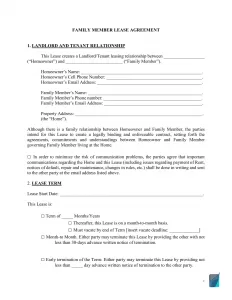
Filling Out a Family Member Rental Agreement
Step 1: Fill Out Landlord and Renter Information
Just like any other lease agreement, you should include landlord and renter names and contact information. Even if the contract is for a parent-child rental agreement you should still list everyone involved as specifically as possible.

Step 2: Term of the Lease
The term of the lease is another way of saying the duration of the lease. You can designate a specific time that the lease expires, becomes a month to month lease, or that the lease is month to month from the start. You can also specify whether the lease can be terminated early or not in this section.
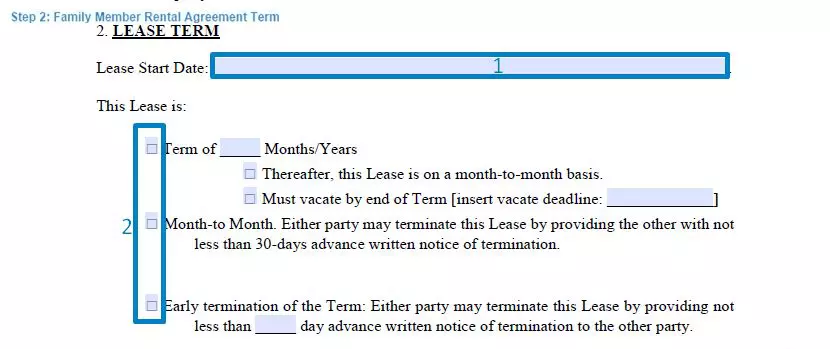
Step 3: Description of the Lease Property
This section lets you describe the property, including any damage already on the property, which areas of the property are being rented, and whether the included space is furnished or not. This is similar to a room rental lease and can be incredibly important if you want to designate different areas of the home for each family member’s use.

Step 4: Rent, Security Deposits, and Utilities
Like any home rental, you’ll also need to include the exact amount of rent, when that rent is due, and any additional security deposit due at the start of the rental. It’s also a good idea to include utilities payments, and whether the renters will pay a flat rate toward utilities, whether certain utilities will be paid in their name, or whether they’ll take a certain percentage of the utility payment each month.
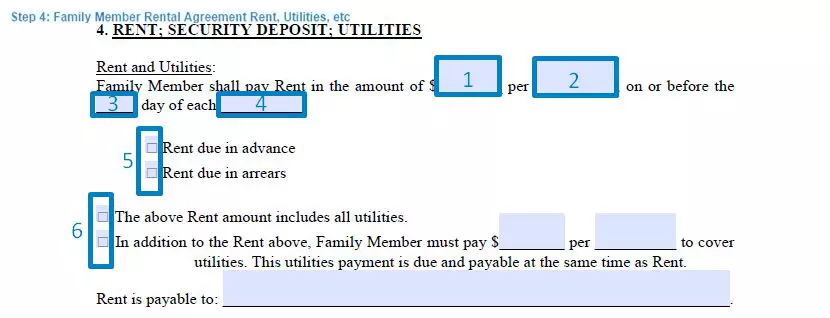
Step 5: Pets and Food
Even if you’re renting space for family you should make sure to include provisions for pets. You can ask for a pet deposit, limit what kinds of pets are allowed, and limit the number of pets allowed. If you don’t want to limit pets or charge a pet deposit you can cross this section out. Like most roommate agreements, it’s also important to discuss how food should be handled on the property. Specifically, this section outlines whether each family member will be expected to eat food they’ve purchased themselves if they’ll have their own storage space and any other requirements or limitations on food in the home.

Step 6: Parking Noise, and Safety
If there is any parking space included in the home rental that space should be listed here, along with any limits on its use. Some properties have noise requirements, or the owner of the property might want to place some limits on noise or require specific quiet hours. Safety agreements include things like keeping the house locked, respecting the people and property inside the home, and whether or not firearms are allowed in the home.

Step 7: Chores, Visitors, and Common Courtesies
This section lets you create rules about who will do which chores, when and how many visitors are allowed in the home, and anything that should be considered a common courtesy expected in the home.
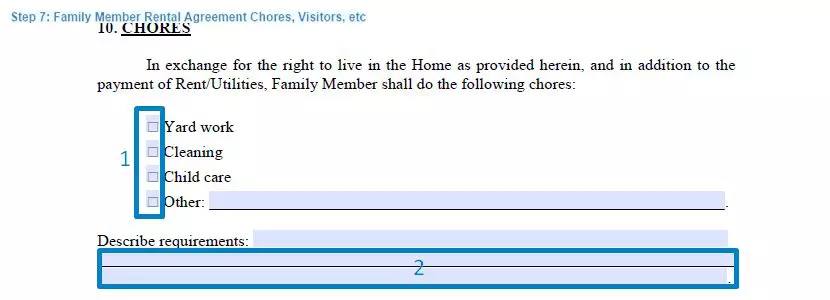
Step 8: Subleasing, Insurance, Defaulting, and End of Lease
This section covers whether family members are allowed to sublease their space. It also covered who is expected to have insurance and how much. The defaulting section covers what will happen if any family member fails to pay their rent, utilities, or anything else. It also covers who will pay for any legal fees that result from non-payment or seeking legal assistance to enforce the terms of the agreement.

Step 9: Additions and Signatures
This last section lets homeowners and renters add any additional requirements to the terms of the lease agreement. Once you’ve covered all the details in the lease, and made sure all your family members agree, all that’s left are signatures. You’ll need everyone included in the rent to sign and date it before the lease can be enforced.
